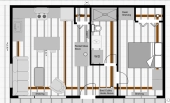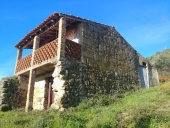posted 3 months ago
Normally, a first-generation batch rocket should be able to start without any smoke in the room. Under a few conditions: the stove must be completely dry, and all building moisture must have been removed. And there must be a sufficient air supply, which in turn depends on the house's construction. In a reasonably airtight house, you can open a window a crack as long as the fire is burning. In a passive house like ours, this is a bit more difficult, which we solved by deliberately setting one of the balanced ventilation presets to an unbalanced setting. The intake fan then runs 7% faster than the exhaust fan, just enough to compensate for the chimney exhaust. When the stove is closed, we return the ventilation to normal.
There are, of course, other options. One is to build the internal chimney into a corner of the bell. This makes installing a bypass much easier. Or you can create a small, narrow opening between the bell and the chimney. This creates a small, permanent bypass, and the main airflow automatically takes the path of least resistance as the stove reaches operating temperature. The flue pipe is no larger than 5 to 10% of the chimney itself.
These features are especially useful when the stove is still wet and therefore quite resistant.
About split firebricks or not: f you use good refractory mortar, 30 mm is perfectly doable. A smaller mass does indeed heat up faster, especially if it's covered in superwool.
I noticed you also posted the same questions on ecologieforum.eu. I post on three forums, but I'm not going to answer double posts. I will answer your questions on one forum, your choice which one.









